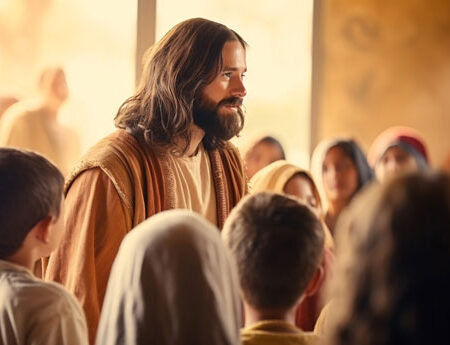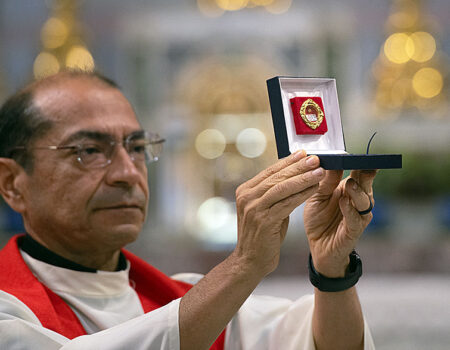‘Dilexit Nos’ and Spirituality of the Heart
Friday June 27, 2025

On 24 October last year, Pope Francis, who passed away on Easter Monday, published his fourth encyclical entitled Dilexit Nos, He Loved Us. The subtitle reads ‘on the human and divine love of the Heart of Jesus Christ’. In other words, it’s an encyclical about the Sacred Heart! This raises the question of why this Pope was so fascinated by this theme. That question is even more significant because we can view this encyclical as the Pope’s will; after all, it was his last major publication.
The encyclical was not received with much enthusiasm. It was described as philosophical and poetic, distinctly different from his earlier social encyclicals, such as Laudato Si’ and Fratelli Tutti. An encyclical is a doctrinal document, making it a challenging read. If you delve into this text, you’ll find that it establishes a solid foundation for his previously published encyclicals.
It should be noted that the Pope did not conceive the subject of this encyclical himself. The fact that Pope Francis was originally a Jesuit holds significant importance here. The Jesuits have strongly promoted devotion to the Sacred Heart over the past centuries. The Pope also makes his Jesuit roots and spirituality evident and palpable in Dilexit Nos. Let’s see what the Pope has to say to us in this encyclical: I will outline some main points.

The heart is a universal symbol. If you stroll through a forest, you may sometimes spot a heart carved into a tree. Occasionally, an arrow pierces it, or two names are inscribed beside it. We all know it isn’t about the organ ticking in our body. No, it signifies the love that has touched two individuals to the core of their being. The heart, then, represents the centre of our lives, where soul and body create a unity that makes our lives genuinely worth living. It relates to our thoughts and feelings, guiding our actions, and is referred to as the place where our conscience and desires reside. Consider, for example, the words of the two disciples at Emmaus: ‘Did not our hearts burn within us as He spoke to us on the road?’ It’s worth noting that there are all sorts of proverbs where the heart is central: What the heart is full of…, having lost his heart…, following your heart. This always points to the essence of your existence. Thus, the heart is understood as a symbol, a visible sign of an invisible, deeper reality.
And then there’s a warning from the Pope, because in today’s hectic society, one runs the risk of losing one’s heart, one’s centre, in a heartless world (17) – a world that focuses on individualism and is fragmented by various technocratic developments. Don’t be fooled, says the Pope; follow your heart and be yourself, and then the challenge arises. Let love define your life (23).
The Dutch Catholic News Agency referred to the encyclical Dilexit Nos as the papal ‘counter-movement’ of the Sacred Heart. A faithful counter-movement exists in a heartless world because, in life, everything culminates in love, which clarifies for us the why and what we live for. That is precisely why we can experience God with our hearts. Then the encyclical (30) says: “Let us go to the Heart of Christ, the centre of his being, which is a burning hearth of divine and human love and which is the greatest fullness the human being can achieve. In that Heart we ultimately learn to know ourselves and learn to love.” That is what this encyclical is all about.
The Bible often discusses the heart, the core of our human existence. Father Jan Bovenmars, a Dutch missionary of the Sacred Heart, has discovered that the word “heart “ appears 1,163 times throughout the entire Bible. It occurs most frequently, 403 times, in Wisdom literature, and 392 times it refers to the hearts of people. In the Bible, the heart is primarily the source of wisdom and the seat of our conscience. Essentially, we use our hearts to seek what truly matters in our lives, making fundamental choices, including the choice for or against God.
A sign of love. The first chapter of the encyclical serves as an introduction, while the second chapter focuses on the Heart of Jesus. This heart is the living core of the Church’s initial proclamation. Therein lies the origin of our faith (32). In the gospels, Jesus is consistently portrayed as a man with a heart, constantly engaging with people, healing and encouraging them, and loving them right up to the cross. This is beautifully expressed in Matthew 11:28: “Come to me all you who are exhausted and burdened, and I will give you rest and relief. Take my yoke on your shoulders and learn from me: I am gentle and humble of heart.”The Sacred Heart devotion that arose from within the church is not, of course, the worship of a part of Jesus’ body, despite how visible that heart appears in all the Sacred Heart images. This has consequently led to numerous misunderstandings over the centuries.
But the whole Christ is depicted in an image of Him. ‘The heart of flesh is the image of the most intimate centre of the Son become man and of His divine and human love, the symbol of His immense love’ (48). To worship the heart of Jesus, therefore, means to worship Christ Himself. Worshipping the heart without the image of Christ behind it is, in fact, unthinkable. There are two texts from John’s Gospel that truly underpin the entire Sacred Heart worship. I will mention them briefly:
In John 7 (37-39), Jesus says: “Let whoever is thirsty come to me and drink. Rivers of living water will flow from the heart of whoever believes in me, Scripture says. By this he was referring to the Spirit they would receive.” And in John 19:33-34, a soldier thrust a lance into the side of the dead Jesus, and ‘immediately blood and water came out.’
Later, this water is linked to the water of baptism and the forgiveness of sins, while the blood refers to the blood that Jesus shed as a sign of the new covenant. In images of the heart of Jesus, we see it pierced. This serves as a fulfilment of Zechariah’s prophecy (12.10): they will look up to him whom they have pierced.
The heart that has loved us so much. Several church fathers and other authors of the time pondered the meaning of these biblical words, with Augustine being the foremost among them. Augustine is often depicted as a man holding a burning heart in his hand. This imagery refers to a passage in his Confessions: “You pierced my heart with your word and I loved you. You touched me and I came on fire for your peace”. Loving Truth ignites the heart in his hand, and Augustine responds to God’s love with unwavering commitment to the church. Invariably, the heart symbolises both human and divine love of Jesus, and the Lord’s wounded side is seen as a source of grace or a call to an intimate encounter of love (78).
Further on in the encyclical, it says: “Devotion to the Heart of Jesus is essential to our Christian life, insofar as it is an expression of our faithful and adoring openness to the mystery of the Lord’s divine and human love, so that we(…) can say that the Sacred Heart is a synthesis of the Gospel (83). The heart of Jesus touches our heart and sets it ablaze, which evokes the image of the heart. However, it remains merely an image, and no one should feel obliged to see it as the core of our faith.
Thirst for the love of God. The encyclical outlines two fundamental aspects of the devotion to the Sacred Heart: a personal experience of trust in the infinite love and mercy of God, and a communal missionary commitment (91). Love is similar in that it is a deeply personal experience, but it is always directed outwards, into the world, towards others; thus, it must be translated into action.
The encyclical features an extensive chapter detailing how various saints have expressed their devotion to the Sacred Heart in unique ways (102 ff.). Initially, during the Middle Ages, monasteries played a significant role in this devotion, but over time, the focus shifted to religious congregations (103).
I mention the name of Johannes Eudes, a priest, theologian, and founder of congregations, who was first authorised to celebrate the Feast of the Sacred Heart in 1672. However, the most significant name belongs to the French nun, Margaret Maria Alacoque, who received apparitions of Jesus between 1673 and 1675, during which Jesus also revealed His heart. When Jesus showed her his heart, he said: This is the heart that has so loved men and spared nothing and went so far as to exhaust itself and be consumed to bear witness to his love before him (119-124). What’s important here is the role of the Jesuit order, particularly Claude de la Colombière, who was Margaret Mary’s spiritual director, supporting her in every way and further spreading her devotion. Moreover, he linked the apparitions of Margaret Mary with the Spiritual Exercises of Ignatius (143 BC); succinctly, the Jesuits played a significant role in promoting the devotion of the Sacred Heart.
_
In the gospels, Jesus is consistently portrayed as a man with a heart, constantly engaging with people, healing and encouraging them, and loving them right up to the cross.
What was the significance of this devotion? Briefly, it bolstered the emotional and human elements of faith during the Jansenist period, which was marked by an intense focus on asceticism and a grim worldview. Moreover, during the 17th century, the era of rationalism, this devotion surfaced as a counter-movement, enabling ordinary people to connect with it as well. Consequently, the Sacred Heart devotion—unlike in previous centuries—experienced significant growth as a popular devotion.
Devotion to the Sacred Heart thrived in eighteenth-century France; however, the French Revolution effectively prohibited all ecclesiastical expressions. After the Battle of Waterloo and Napoleon’s defeat, devotion to the Sacred Heart flourished not only in France but also throughout Europe, symbolising the ecclesiastical revival that followed the French Revolution. In 1856, Pope Pius IX declared the Feast of the Sacred Heart a celebration for the global church, and in the Netherlands, many homes and churches prominently displayed the Sacred Heart statue. The Sacred Heart became a symbol of the renewed ecclesiastical fervour of the era.
Remarkably, the Sacred Heart devotion inspired numerous missionary activities (150), including the Missionaries of the Sacred Heart, a congregation established in 1853. The Sacred Heart was central, not only as a devotion to remember Jesus for all the suffering he endured for our sake but also as a prayer for the salvation of sinners. The founder of the congregation viewed the Sacred Heart devotion as a remedy for the ills of his time, primarily identifying these as selfishness, materialism, and religious indifference. Furthermore, he believed that it was not just the religious who needed to raise a counter voice in the world; he actually regarded this primarily as a task for the laity.
Later, the Pope expressed it this way: the Gospel, in its various aspects, must not only be contemplated or mentioned but also lived out, both through acts of love and in inner experience. This is especially true regarding the mystery of Christ’s death and resurrection (156).
Giving love, receiving love. The last chapter of an encyclical is typically practical, and this encyclical is no different. It is not just about loving the Heart of Jesus; it also involves responding to that love (166). The subsequent paragraph of the encyclical is titled ‘Continuing his love to the brothers and sisters’, which echoes Francis’ own tone. We are frequently reminded of this in the Gospel; in fact, it expands on the commandment to love our neighbour as ourselves (167). A bit further on, it states: ‘Love for brothers and sisters is not made, it is not the result of a natural effort of strength on our part, but it requires a change of our selfish heart’ (168).
And later adds: Mission, understood from the perspective of radiating the love of the Heart of Christ, calls for missionaries who are in love and still enamoured with Christ and who cannot help but pass on this love that has changed their lives. In a final paragraph, it is stated that this mission to share Christ would only be something between me and Him. Mission is lived out in communion with one’s own community and with the church. If we distance ourselves from the community, we also distance ourselves from Jesus (212). There is no distinction between serving the community and serving Jesus. After all, all that we have done for the least of our brothers we have done for Him (Matt 25:40) (213). Jesus sends you out to spread goodness, and He prompts you from within. Therefore, He calls you with a vocation to service. We want to be led by Him because He has said that He will be with us until the consummation of the world (215).
Final. In conclusion, the Pope states, “This document helps us to discover that what is contained in the social encyclicals Laudato Si ‘and Fratelli Tutti is not alien to our encounter with the love of Jesus Christ, because when we lavish ourselves on this love, we are able to establish fraternal ties, to recognise the dignity of every human being and to take care together of our common home (217). Christ’s love is outside the perverse cog of money and power, of entertaining and consuming; He alone can free us from this fever in which there is no more room for disinterested love. He is able to give a heart to this earth and reinvent love there, where we think the ability to love has died forever (218).”
My conclusion after reading this encyclical is that the text is quite comprehensive and wide-ranging. In fact, the entire history of the Church regarding the theme of the Heart of Jesus is discussed. Importantly, this piece underpins the Pope’s social encyclicals as well as many other writings. In doing so, the Pope effectively utilises what he received from the Jesuit circle. On several occasions, he emphasises that we should not be blinded by that heart so prominently displayed on Sacred Heart statues. Within the Church and our world, the heart represents love and a commitment to our fellow human beings and society. The Pope believes that our society is often lacking in compassion; therefore, the Church should be a community of love, capable of renewing the world, inspired by the spiritual power of Jesus.
Jos Vriesema, LCF (Nederlands)
Photos: www.freepik.com





